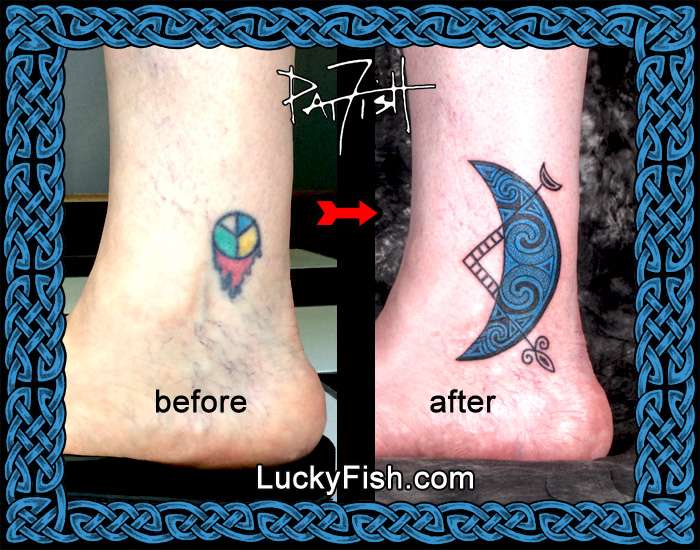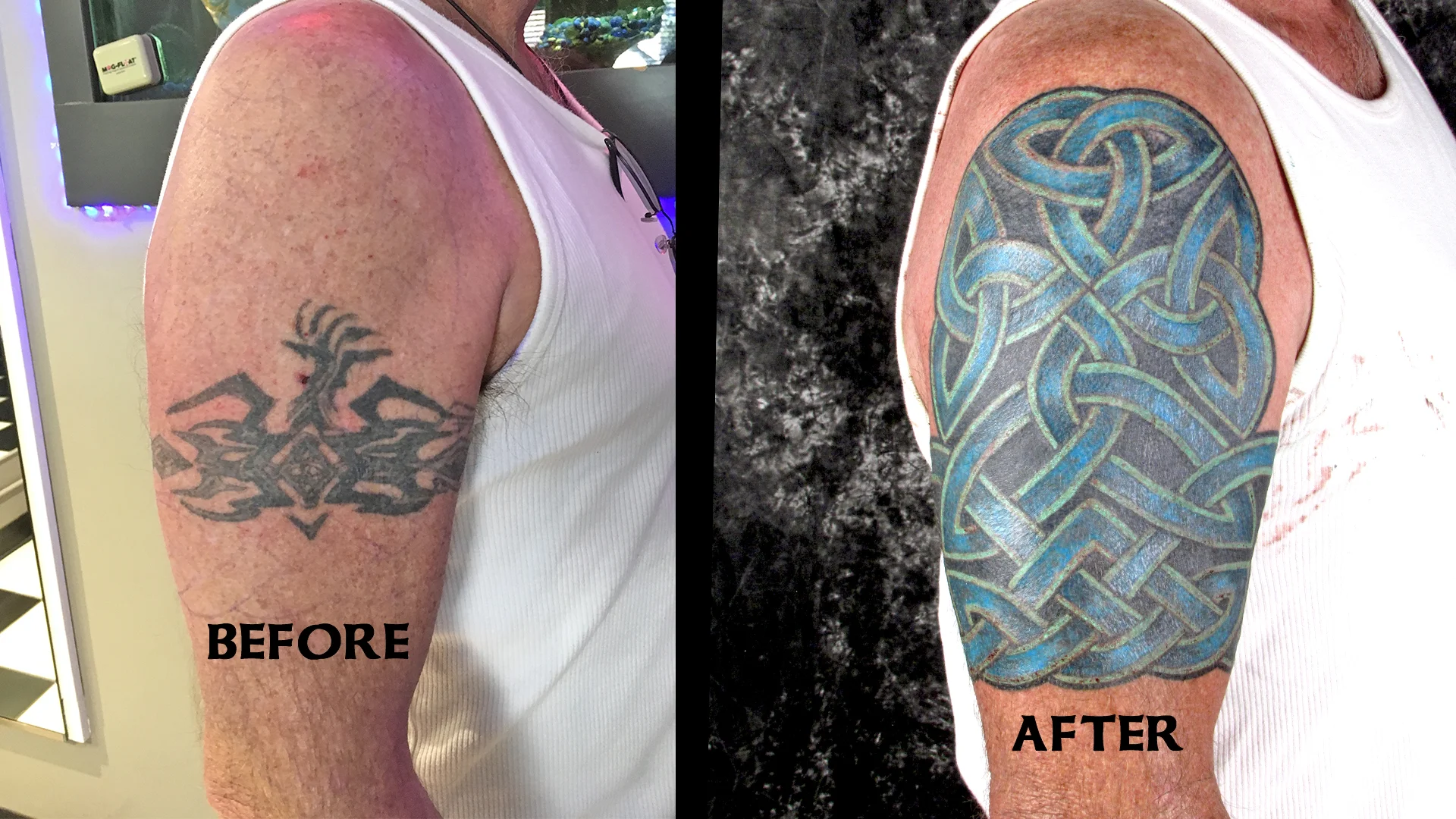Cover-up Tattoos
A well done tattoo is a thing of beauty that gives pleasure to the wearer. But sometimes, due to an initial poor impulse or inadequate application, what should be a permanent expression of your internal aesthetics may begin to feel like a regret.
No tattoo artist prefers to do covers-ups, but they are a necessary part of our repertoire. A person with a tattoo they no longer want is not as enthusiastic to get the next one as we'd like, a bad thing for the tattoo industry as a whole, so getting them back on track is a good deed. I usually don't advertise that I do this, but of course I do. Below you will find some examples of work I have done, and if you are stuck with a tattoo that is no longer serving you well, be in touch and we can work together to make it something you can be proud of.
A tattoo is a permanent expression of your personal aesthetics, announcing to others your enthusiasms and taste.
Don't stay stuck with something inadequate.
The problem can be as simple as the tattoo being the wrong size. Many people start timid, and only later realize that their choice to get a small tattoo in a prominent body part now looks like a sticker.
With Celtic designs this is especially problematic, because there is a minimum scale required for the knotwork weaves to be able to age well. Since all tattoos blur over time, if a Celtic design is too intricate at too small a scale, the pattern will become indistinct and muddled as time passes.
In this first example several problems arose as this man aged. The circle was too small for that amount of knotting, and colored too darkly.
Unfortunately he also went to a tattooist who was, perhaps, inexperienced with working with Celtic designs, and so there were places in the knot where the pattern went awry. Once there are two overs in a row, not the mandatory over-under-over of a weave, the whole design starts to unravel.
When we consulted about it, my recommendation was to cover it completely. I could have spent a lot of time and effort trying to "open up" and repair the old piece if it had great sentimental value, but the result would never have been of sufficient quality.
Also notice how it is not well placed on his arm. It is possible that when he was a younger man his arm was shaped differently, and it then appeared higher. But the arm is a different size now, and it appeared now lower than it should have been to center on the deltoid muscle to be viewed to best advantage.
So, it had to go.
Fortunately he had the ambition and stamina to go much larger, and I created this custom pattern to cover it up completely. Blue is by far the best color to use when covering a dark tattoo, the best option when trying to avoid the more-so traditional solution of a big black tribal swoosh or an 8-ball or a bomb with a fuse.
But doing an entire shoulder cap in blue and black wasn't quite necessary here, and would have been a very dark and solid statement. So the pattern has blue where necessary to accomplish the obscuring of the circle, then those lines flow out and connect to weave throughout the arch and the band that goes under the arm and connects back up in the back.
Celtic designs should have lines that weave and return to source, and provide a level of intricacy in construction as well as an overall aesthetically pleasing form on the body. Selective coloring, or rendering parts in different ways, can sometimes make it easier for the logic of the pattern to be seen.
An important consideration in covering up a tattoo is picking the best overall silhouette, thus obscuring the compromises which may be necessary to achieve the masking of the old work.
In the case of this eagle, the fellow started out with the name of a now ex-wife. When it was time to marry wife #2, it had to go. Unfortunately in his enthusiasm to go to the altar again a changed man he did not choose his artist wisely, and the small inset circle shows the "eagle" that was placed over the name. Aside from a vague resemblance to the Harley wings logo it is hard to imagine it as a bird of any sort.
I proposed that we give him the eagle he always wished it had been. But I also insisted that having the tools of his master plumber's trade inserted into the talons was a worthy addition. No arrows of war here, plumbers' wrenches are raised in a triumphant gesture.
I will admit that initially he was hesitant to have the tools in the talons, but I showed him my concept drawing and asked that he show it to both his wife and the crew that works for him. It met with universal approval, and now he wears this unique tattoo proudly.
The most difficult part of this cover-up was having almost no negative space between the wings, so I had to draw them in such a way as to cover the old upraised blob wings but coming no closer in the middle than absolutely necessary, This resulted in a much larger tattoo, appropriately sized to his arm, and there was no way to avoid the black blob landing under the white eagle head. That required several coats of white, as well as white highlights on the feathers.
This next example of an ambitious cover-up is a redemption. The man had a wayward youth, and in his association with rough companions received many amateur tattoos in questionable circumstances. They were of sentimental value to him, as markers of his adventures, but most decidedly not attractive to his loving wife.
She decided to bankroll his transformation, and the progression of photos shows the process.
The tattoos were quite dark, and so a Celtic knotwork forearm of very bold links was chosen. On the first day only the lines were fitted and installed, and the black background filled. In the second session shading was added to obscure the old tattoos, drawing out the shading away from the old ink, so that the old spider and raven etc. would not be able to ghost back up to the surface later. In a third session a blue line was placed down the middle of each braid line, and then threaded on the sides with a light green pin-stripe, which draws the eye and lightens the whole, making the weave rise up from the black background.
His Missus is quite pleased with the result, and he is much more acceptable in polite society now. Instead of being viewed as a potential hoodlum, he wears compelling ethnic art.
The pattern on the left above shows a very challenging cover-up. He initially had his last name poorly lettered, and he then asked someone to enclose it in a Celtic cross. The cross was placed up onto his neck, something I would not have done, and then it was left partially completed with bits of the letters sticking out. I designed a custom cross to obscure the old work, and needed to shade it quite heavily to affect the change.
On the right is one of the few times I have covered up a tattoo I did. The "before" tattoo dates from very early in my career. My friend had come back from military service greatly disillusioned, and asked for an upside-down peace sign dripping blood. Recently, decades later, we covered it with the Pictish crescent and v-rod. It is a centuries-old pattern that bespeaks his heritage, and might likely have been worn by the honorable warriors of his race in that ancient time. Taken from a carving on a standing stone in Scotland, it is a positive and timeless mark to heal and move forward with.
In this animated sequence we see the beginning tattoo, which I cannot explain, and the progression of covering it up.
First the stencil of the purple ink pattern is placed, making sure it is well centered and fully covers the old tattoo.
Then in the first session a black line is put in, with wickering shading to accentuate the weave of the knots, and a stippled dotted background to fill the negative spaces. Dots are often as effective as solid black in covering an old design, and in this case more so because the old tattoo had raised scarring.
In the next photo we see the tattoo colored, and the cover-up is complete.
The last photo shows the tattoo after some months, and it is easy to see that the coverage that looked quite effective when it was freshly done has faded, and the old tattoo is now slightly visible, "ghosting" back up through the new one.
Sometimes, after healing, it is necessary to go back in yet again and do a "second coat" of color in the cover-up to really be sure that it completely obscures the old tattoo. It is similar to applying a white coat of paint on a dark wall. While the paint is wet the white seems quite bright and solid. As the paint dries imperfections show, and the necessity for a second coat of paint is obvious. So it is with cover-ups. They are not easy, and often require multiple sessions before they are complete. But compared with laser removal and other methods of destruction, they leave the skin in perfect condition and set the wearer free to enjoy life as a well-tattooed individual.
Twenty years ago I met this man and told him he needed to cover up his tattoo. It took him that long to come around to doing it, but after much consideration we finally finished a multiple-session half-sleeve and now he has an entirely new tattoo that he can wear proudly.
Celtic cover-up tattoo by Pat Fish
Here you can see the before and after.
The tribal band becomes a Celtic sleeve
To best explain this transformation, here is a short video showing it in progress.
And last, a sentimental story. This elderly gentleman came in sporting a classic WWII tattoo, the cherry with the words "Here's mine, where's yours ?" It may have been appropriate in the 1940's, but neither the tattoo nor the joke were wearing well. He said he had just lost his wife of many decades and did not want to go to his grave wearing this. So we picked out a classic old school rose from the same era, and then placed the name of his beloved wife, Noellan, above.
I do hope that these examples may give hope to those who have thought they were stuck with a poor tattoo. It takes more effort than a tattoo done on clear skin, but in most cases the client is so much more grateful! Especially in the case of people who got tattooed very young, their options for artists may have been limited and their aesthetic preference might have been appropriate then but not now.
I stand ready to help in the transformation.







